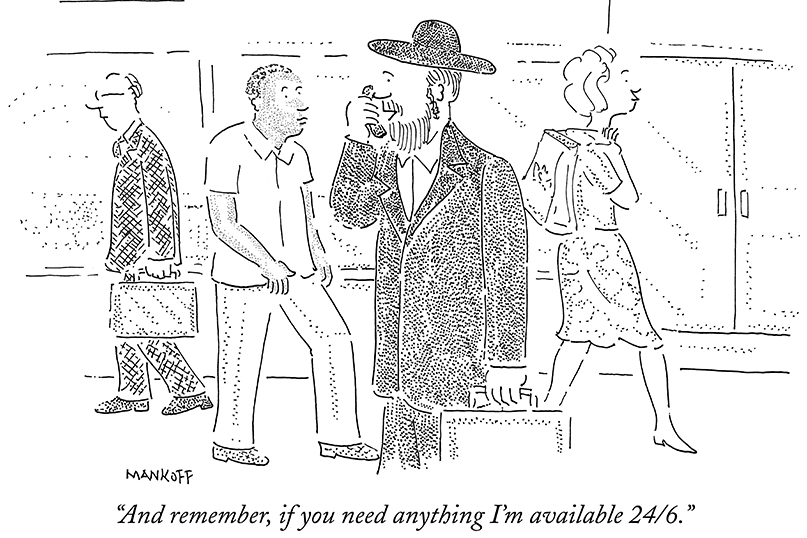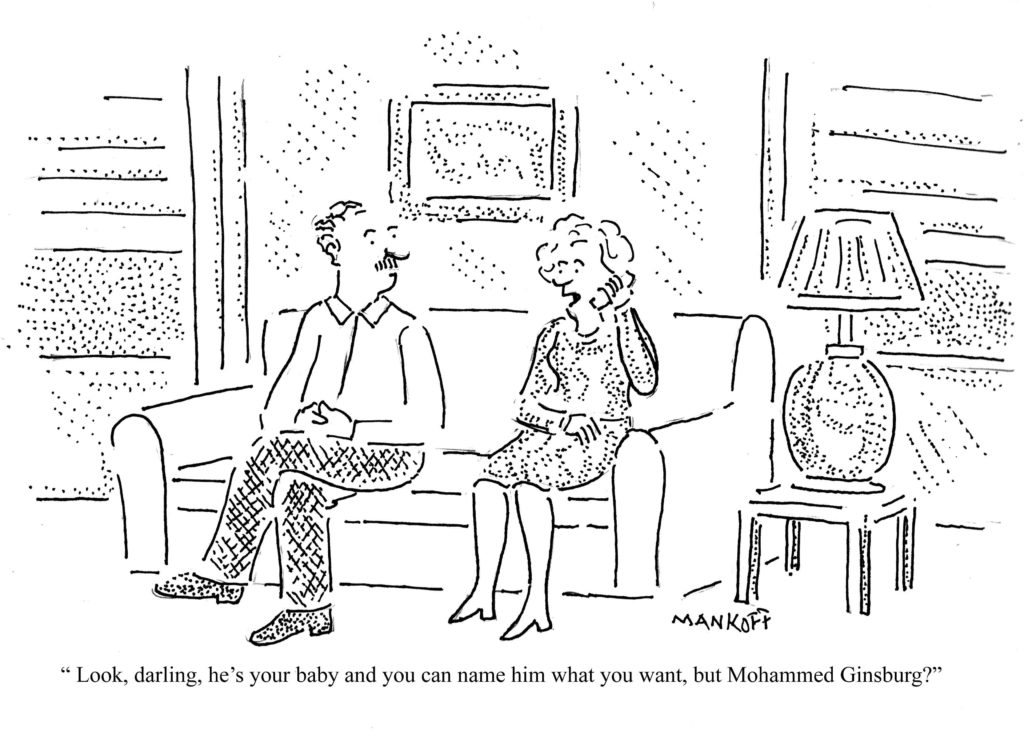
A conversation with Bob Mankoff, former cartoon editor of The New Yorker magazine
By Stacey Dresner

HARTFORD – In his new book Have I Got a Cartoon For You! The Moment Magazine Book of Jewish Cartoons (MomentBooks Original Trade Paperback; fall 2019), Bob Mankoff, former cartoon editor at The New Yorker, gathers his favorite Jewish cartoons – from his own collection as well as from 27 of the best cartoonists in America.
Mankoff, who for 14 years served as cartoon editor for The New Yorker magazine, will examine the place of cartoons in the vigrant history of Jewish humor at the UJA-JCC Greenwich Annual Meeting on Thursday, Dec. 5 at 7 p.m.
He will also deliver the Mark Twain Birthday Lecture on Tuesday, Dec. 17, 7 p.m., at The Mark Twain House & Museum in Hartford.
Currently the Cartoon Editor at the weekly online newsletter Air Mail, and former cartoon editor at Esquire, in addition to The New Yorker, Mankoff grew up Jewish in Queens, New York in the 1950s and 1960s. As a kid, he visited the Borscht Belt and reveled in the hilarious performances of some of the best Jewish comedians including Jerry Lewis, Buddy Hackett, and Rodney Dangerfield. These early experiences helped shape Mankoff’s view of life and led him to become a creative master practitioner of humor and cartoons.
He is also founder of Cartooncollections.com, a cartoon licensing database featuring cartoons from publications including The New Yorker, Esquire, National Lampoon, and newer sources, such as The Rejection Collection and The American Bystander.
In addition to his latest book, Mankoff is the author of the memoir, How About Never – Is Never Good for You?: My Life in Cartoons.
The Jewish Ledger spoke to Mankoff about his career as a cartoonist and Jewish cartoons.
JEWISH LEDGER (JL): Can you tell us about your Jewish upbringing?
BOB MANKOFF (BM): Well, I went to the same synagogue as Mark Twain (laughs). I was born in the Bronx; I grew up in Queens. I was bar mitzvahed. Since then I have observed Judaism from afar. I’m indebted to my Jewish condition but not to its religion.
JL: I read that as a kid you loved going to the Catskills and seeing all of the Jewish comedians, like Jerry Lewis, Buddy Hackett, Rodney Dangerfield, Jackie Mason, etc. Did you want to be a comedian like them?
BM: I did actually want to be a comedian. I also drew and I went to the High School of Music and Art and I wanted to be a cartoonist. And I’m a cartoonist because when I left graduate school in ’72, there may have been a few comedy clubs, but I would have had to go back to the Borsht Belt to be a comedian and I wasn’t ready to do that. So I struck out in, I guess about ’73, to become a cartoonist. But that’s the road not travelled, let’s put it that way.
JL: How did you do as a cartoonist early on? When you finally sold a cartoon to The New Yorker, was that the big time?
BM: Well, it was a big deal, but I sold cartoons right away to Saturday Review of Literature, which was a magazine, so I sold cartoons pretty quickly. But it took me a number of years on and off actually submitting to The New Yorker until I sold my first cartoon there in 1977. It’s where I really wanted to be especially because – my quote is, “The New Yorker was to magazine cartooning what God is to religion.” Really.
So it defined the magazine cartoon. It didn’t invent it, but it certainly popularized it and made it a cultural icon.
JL: And later you became cartoon editor at The New Yorker. How was that different from just creating your own cartoons?
BM: It’s a lot easier rejecting stuff than being rejected. But it’s enormously different – a whole different set of muscles in terms of judgment versus creation and editing and mentoring. You know, I brought in a whole generation of people who are now actually the mainstays of the New Yorker cartooning enterprise. So I would be looking at a thousand cartoons every week and then picking the 40 or 50 to take into the editor, first Tina Brown and then David Remnick, doing my own cartoons, editing books of cartoons like The Complete Cartoons of The New Yorker, and just last year The New Yorker Encyclopedia of Cartoons.
So it’s very different and it’s great in a way, and it’s not so great in terms of creativity because when you see that much material it is actually harder to create new material yourself.
JL: Are cartoons today different then when you first began?

BM: Cartoons evolve; They change all the time. When I started cartooning, the idea of “the gag” was a much more universal thing – it was sort of a question of who came up with the idea first rather than the joke being linked to the person’s personality. I think that is a big difference.
A lot of today’s cartoons are, I’d say, sort of autobiographical. You relate to them; you relate to the personality of the people who do it. I think that’s certainly true of a lot of the new women cartoonists who are doing cartoons now. Roz Chast probably pioneered in that. If you would look at a cartoon of mine that I did, I don’t know, in the ‘70s, you wouldn’t necessarily know anything about me, except maybe you would think I was clever or funny. If you look at Roz Chast’s cartoons you know a lot about Roz.
JL: Let’s talk about your new book, Have I Got a Cartoon For You: The Moment Magazine Book of Jewish Cartoons. When did it come out?
BM: It’s Jewish and it’s newish. It came out in September.
JL: What prompted you to write a book on Jewish cartoons?
BM: Well, I was out walking, out where I am in Briarcliff Manor, where it is still countrified. And there was a bush. And all of a sudden that bush started to burn. (Laughs.) And a voice from the bush said, “Do this book.”
Why? Well, when I left The New Yorker two years ago – for appropriate behavior – I realized that I was free to do a lot of things I couldn’t do before. At The New Yorker we really weren’t going to do a book of Jewish cartoons. At The New Yorker there really weren’t enough of those kinds of cartoons.
I had a relationship with Moment Magazine and Nadine Epstein, the publisher. I did a caption contest for them, which is now being done by a colleague of mine, Ben Schwartz, that was like a New Yorker caption contest but related to Jewish themes. We had always talked about doing a book of Jewish cartoons but I really couldn’t do that when I was at The New Yorker. So when I left The New Yorker and started a new company, Cartoon Collections.com, which licenses New Yorker cartoons, cartoons from Esquire, cartoons from the Wall Street Journal; anyway, it’s the world’s biggest resource for licensing cartoons, I realized we had a lot of Jewish cartoons that didn’t appear in The New Yorker, and I thought of Nadine and then I thought – “Hey, why not do a book of Jewish cartoons,” really because I like to do things and that seemed like a good thing to do. I don’t think it was anything deeper than that.

JL: So are Jewish cartoons funny to everyone? Do non-Jews get them?
BM: Not all the cartoons in the book are done by Jewish cartoonists. I mean, some of my best friends are non-Jews.
I think Jewish humor is part of American humor now. In fact, Jewish humor has had a huge influence on American humor and a lot of what we think of as American humor now is Jewish humor created by Jews going back to Vaudeville, through radio and films and TV. In 1980 or ’79 maybe there was a survey done and 80 percent of the people in American comedy had a Jewish background. I don’t think it’s that percentage now but it’s still pretty large.
One of the things Jewish humor is known for is actually being self-deprecating. So the Jewish humor for the most part is not aggressive against the outsider; it’s sort of ribbing the insider.
Freud wrote a book in 1905, Jokes and their Relation to the Unconscious and most of the jokes in that book are Jewish jokes. Jewish jokes make fun of being Jewish, either assimilating or often what they use is our kind of contorted cultural Jewish logic twisted on itself to make the joke.
The best Jewish jokes are not really mean or aggressive or sexual or transgressive. They are more logical and sort of turned in on themselves. So there are some of those. And some of them are slightly political in a way. There’s one where Moses is leading the tribe through the Red Sea and one of the followers is saying, “Oh, he’s alright, I just wish he was a little bit more pro-Israel.”
The final cartoon in the book is a tombstone which says, “It killed him to call.”
So the main thing about the book is it makes makes gentle, benign fun of Jews. I don’t think it’s going to be favorite book of the alt-right.
Bob Mankoff will speak at:
UJA-JCC Greenwich Annual Meeting; Thursday, Dec. 5, 7 p.m. at the YWCA, 259 E. Putnam Ave. in Greenwich. FREE for donors of $18 or more. For information: (203) 552-1818, info@ujajcc.org. Dessert and coffee will be served. RSVP requested.
The Mark Twain Birthday Lecture; Tuesday, Dec. 17, 7-9 p.m., at the Mark Twain House in Hartford. Tickets: $18.35, (the year of Twain’s birth).








 Southern New England Jewish Ledger
Southern New England Jewish Ledger








